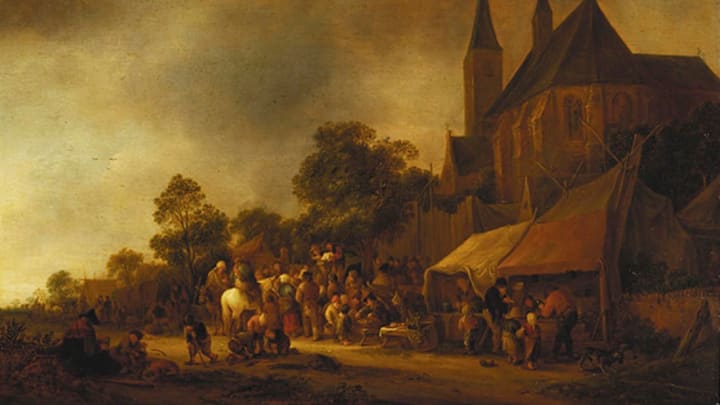Art conservators for the UK’s Royal Collection were in for quite a surprise when they set about cleaning Dutch artist Isack van Ostade’s A Village Fair, With a Church behind, an oil painting completed in 1643.
The painting, which was being prepared for the 2015 exhibition “Masters of the Everyday: Dutch Artists in the Age of Vermeer,” had darkened and yellowed over time. However, when they began examining the work, conservators also noticed that a bush in the corner of the painting was a very recent addition, not a part of the original artist’s vision. When they removed it, they found quite a different market scene than they expected.
When the restoration work was done, this is what the painting looked like:

Wait, what’s going on in that bottom right corner? Oh, it’s a guy squatting down to poop.

Obviously, porta-potties weren’t a part of 17th-century village life, so a day at the market would also necessarily involve answering the call of nature in a semi-public place. Van Ostade was just being a realist … with a healthy dose of toilet humor.
King George IV bought the oil-on-wood painting while he was still heir to the throne, and hung it in his London house. Exhibition curator Desmond Shawe-Taylor said that “George IV loved that kind of thing … Being a man of the world, [he didn’t] mind a few rude jokes.” The curators of Buckingham Palace’s art collection certainly did, though. In 1903, the painting was restored before it was moved to the palace picture gallery, seemingly with the first addition of a tasteful bush.
“Dutch artists often include people or animals answering the call of nature partly as a joke and partly to remind viewers of that crucial word ‘nature,’ the inspiration for their art,” Shawe-Taylor said. “Queen Victoria thought the Dutch pictures in her collection were painted in a ‘low style’; two years after her death perhaps a royal advisor felt similarly.”
Restoring the painting was a lengthy process that began with using solvents to dissolve the varnish covering the artwork and removing what overpaint they could from previous restorations—including the bushes, which Adelaide Izat, paintings conservator at the Royal Collections Trust, said she left until near the end of the initial part of the restoration process. “I really wasn't expecting to find anything underneath,” she said. Removing the varnish (and the bushes!) “returned the paint film to what the artist originally intended.” You can see hear her break down the process in the video above.
Read More Stories About Art:
A version of this story ran in 2015; it has been updated for 2024.
